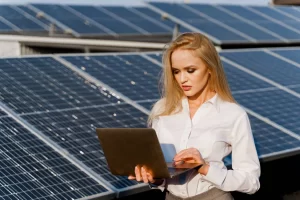 Solar panels act as a source of electric current, which is obtained by converting solar radiation entering the plates into electricity. Alternative sources of electricity are now more relevant than ever.
Solar panels act as a source of electric current, which is obtained by converting solar radiation entering the plates into electricity. Alternative sources of electricity are now more relevant than ever.
For example, solar energy is renewable, virtually inexhaustible, and can generate environmentally friendly electricity without harming the environment.
Solar panels consist of:
- Photogenerator of the semiconductor type, which converts the energy of the sun into an electric current;
- An inverter, thanks to which the current will turn into an alternating current, that is, the one used in electrical appliances;
- A controller is needed to monitor the battery charge.
- Accumulator batteries for storing energy during daylight hours and returning it to the consumer in the evening and at night.
These panels have many advantages:
- Solar energy is free and inexhaustible.
- Does not harm the environment.
- For maintenance, it is enough only to clean the batteries from dust.
- It is possible to get energy where there is no centralized network.
- Can be combined with other electrical equipment.
- It pays off quickly.
But there are also disadvantages:
- High cost of equipment.
- The efficiency is quite low.
- Direct dependence on the sun.
Principles of operation of solar panels
- Photons that hit the surface are absorbed by the working material.
- Photons knock out native electrons, colliding with atoms of matter.
- At the same time, we get a potential difference, and active electrons begin to actively move to compensate for the difference, which leads to the generation of an electric current.
- The current will turn into a constant current, which goes to the battery or the consumer.
The cost of solar panels
Before making a purchase, you should decide how much you can invest because an average-sized panel costs about $500.
You will also face other costs for installing solar panels, such as:
- purchasing an inverter that converts solar energy into alternating current (costing about $1,000);
- batteries, which are needed to store electricity;
- a controller that controls the entire process.
Naturally, you will also need fasteners. If you want to completely abandon the network, then the installation will cost up to $10,000.
However, after spending this amount once, you will get a unique opportunity to have electricity on the grid.
In addition, it is estimated that the installation of 30 kW solar panels pays for itself in 6-7 years.
Developments in the field of solar energy are constantly moving forward along with the optimization of materials and their prices.
Given this fact and other advantages of solar power plants, it can be argued that solar energy will only develop every day and become more popular as an environmentally friendly generator of electricity, as well as a source of new income.
Picture Credit: VistaCreate
